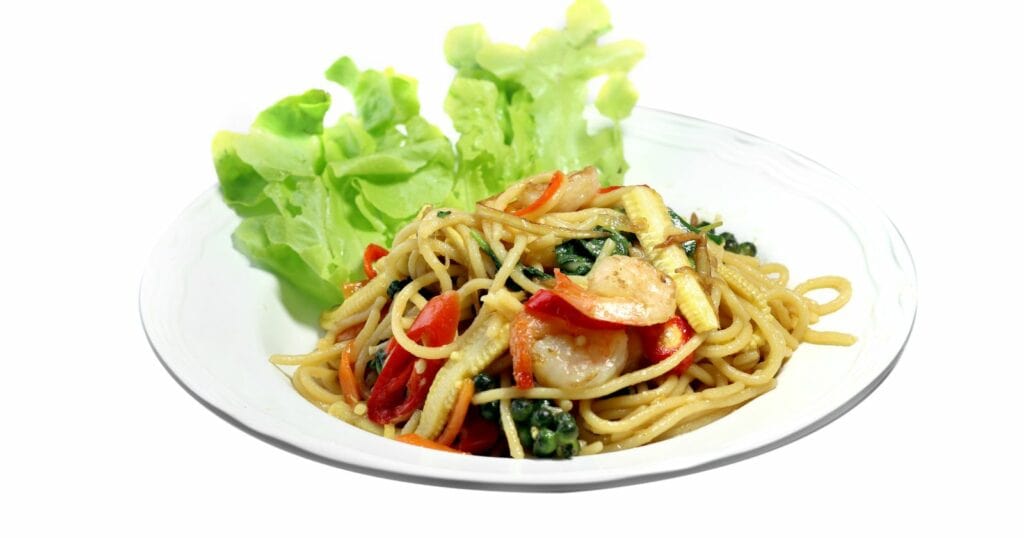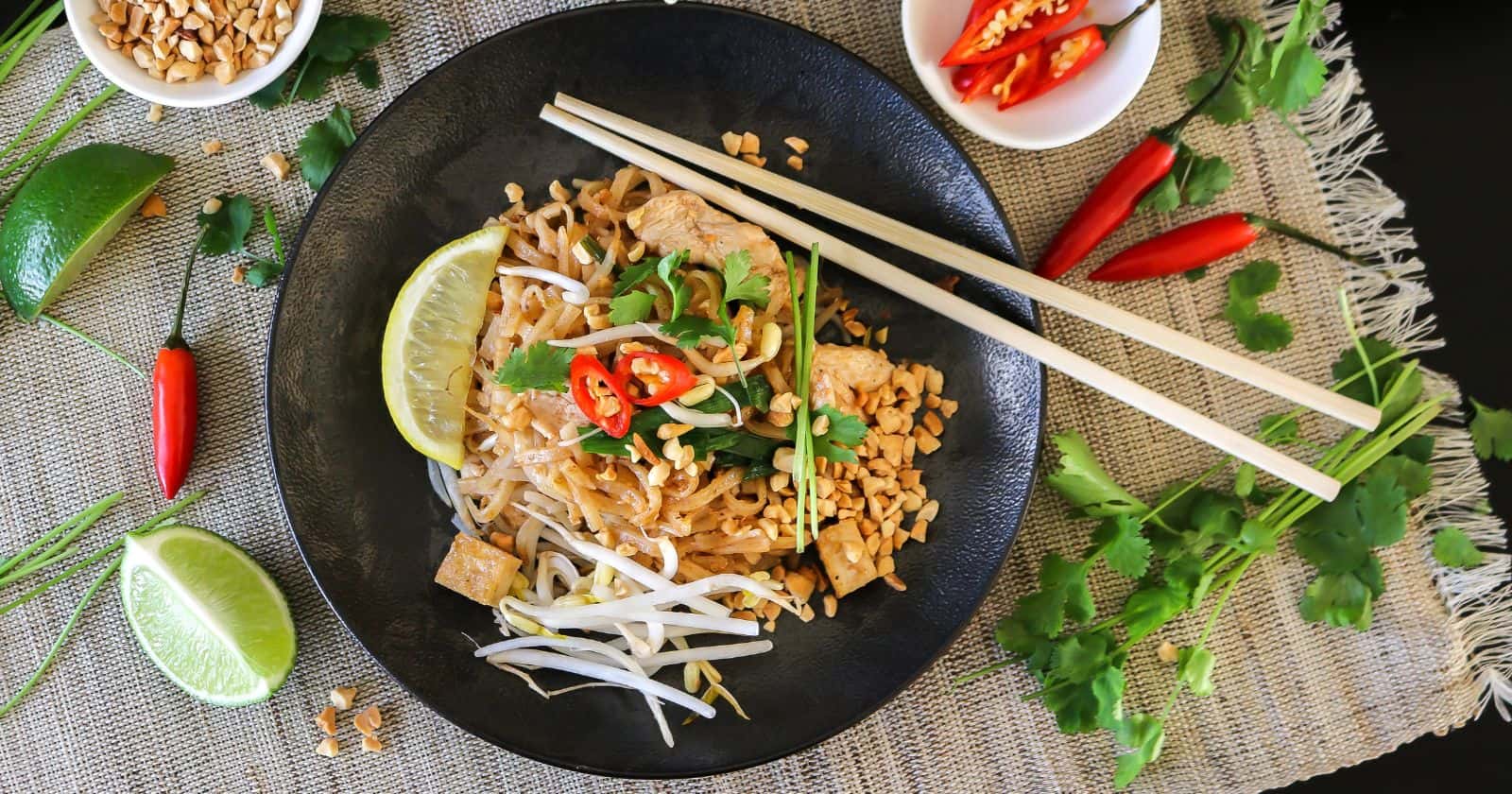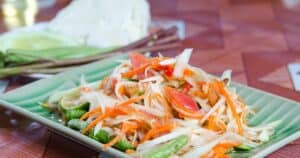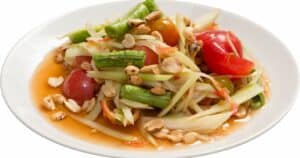Pad thai is one of the most crave-worthy Thai dishes. But if you’re sensitive to
Here’s the burning question I always get asked: Is pad thai supposed to be spicy?
The answer isn’t a simple yes or no. Authentic pad thai contains a mild kick of heat from chili flakes and white pepper. But the
Some chefs and regions make it spicier than others. Street stalls in Thailand tend to amp up the heat more than Westernized restaurant versions.
Luckily, there are easy ways to customize your pad thai
So don’t let a little potential heat stop you from enjoying the sweet, tangy magic that is pad thai. Keep reading for tips on getting this iconic noodle dish with just the right amount of sizzle for your tastes!
What is Pad Thai Exactly?

Before we talk
Pad thai consists of thin rice noodles stir-fried with eggs, tofu, shrimp or chicken, peanuts, garlic, and tamarind paste. It’s seasoned with fish sauce, palm sugar, and lime juice.
The dish has a magical sweet, sour, and savory flavor combo. It’s topped with bean sprouts, chives, crushed peanuts, and often a wedge of lime.
Pad thai likely originated in Thailand in the 1930s-1940s. Its popularity spread worldwide, making it one of Thailand’s national dishes today.
Now, let’s tackle the spicy question.
Is Pad Thai Traditionally Spicy?
Authentic pad thai does tend to have a little kick of heat. But it shouldn’t be overly spicy if made traditionally.
The
Some pad thai recipes also include a dash of white pepper or a spoonful of spicy Sriracha sauce. This can amp up the heat level a bit more.
So traditional pad thai does aim to have a gentle
With that said, pad thai
How Spicy Your Pad Thai Will Be
The exact amount of
- Personal taste: Some Thai cooks like more heat than others and will adjust accordingly.
- Location: Pad thai in Thailand is often spicier than versions cooked abroad.
- Restaurant style: Street food stalls tend to make it spicier than restaurants catering to tourists.
- Region: Northern Thai pad thai features more chilies than Bangkok-style.
- Customization: You can always request mild, medium, or spicy heat.
So while pad thai is meant to be just mildly spicy, you may get a big range depending on where and how it’s prepared.
Tips for Ordering Pad Thai with Your Preferred Spice
To get the right
- Ask if it’s mild, medium, or spicy. Many Thai restaurants will adjust for your preference.
- Request no chili flakes or sriracha in the sauce if you want it mild.
- Add fresh sliced Thai chilies on top if you like extra heat.
- Say no white pepper if you don’t want the extra kick.
- Order chicken or tofu for a milder version than shrimp.
- Ask for a side of chili sauce to control the amount you add.
- Cool your mouth between bites with creamy coconut rice.
- Drink something sweet like Thai iced tea to counterbalance the heat.
With a few customizations, you can easily get pad thai with just the
How to Make Pad Thai Less Spicy at Home
Want to recreate restaurant pad thai at home but aren’t a fan of big
- Use mild red pepper flakes instead of Thai chilies in the sauce. Or skip chilies altogether.
- Add a spoonful of sugar to the sauce to offset any heat.
- Mix in cooling ingredients like bean sprouts, shredded carrots, or cucumber.
- Top with tangy lime juice and sliced green onions to balance the flavors.
- Drizzle the noodles with honey if the
spice level still seems too high. - Serve with a sweet mango salad to complement the heat.
With a few simple adjustments, you can whip up a customized pad thai that even
What Makes Pad Thai Spicy in the First Place?
Now that you know how to tame the heat, let’s look at what gives pad thai its signature sizzle:
Dried Red Chili Flakes
The main culprit for spiciness in authentic pad thai is dried red chili flakes blended into the tamarind paste sauce. Red chilies have a nice fruitiness that pairs well with the sweet/sour tamarind. But they can quickly amp up the heat, especially in large amounts.
Fresh Thai Chili Peppers
Many pad thai recipes call for sliced fresh Thai chilies as a garnish or mix-in. These small chilies pack some serious punch, especially the red and green varieties. Just one can set your mouth ablaze!
White Pepper
In addition to chilies, white pepper is a popular way to add zing to pad thai. White pepper has a sharper, more intense heat than black pepper. Just a pinch can enhance the
Sriracha Sauce
Rooster brand Sriracha is now a Thai restaurant staple. Made from chilies, vinegar, sugar, and garlic, this thick sauce contributes a sweet yet searing heat when drizzled onto pad thai.
Optional Chili Paste
Some cooks like adding chili-garlic paste or chili crisp oil to pad thai for extra oomph. These oily, pungent pastes can ratchet up both flavor and
Should You Avoid Spicy Pad Thai Altogether?
Even if you’re sensitive to
Getting it customized to your preferred heat level still allows you to enjoy the addictively complex flavors – just without all the fire.
And you may find that a little
So don’t be afraid to try pad thai or order it at varying
Pad Thai vs. Drunken Noodles: Which is Spicier?

Pad thai is often compared to drunken noodles, another Thai staple. If you dislike
Here’s a quick heat comparison:
- Pad thai gets its mild
spice mainly from chili flakes and white pepper. - Drunken noodles feature slices of hot fresh peppercorns, pepchili-garlic sauce, and spicy basil.
So drunken noodles contain more raw heat from fresh chilies. The basil also gives it a sharper, peppery bite.
However, pad thai made with extra chili paste or Sriracha can compete in the
In general, I’d say drunken noodles have more potential to be mouth-numbingly fiery. But pad thai can still pack some punch if amped up. Let your personal heat tolerance guide you!
Final Thoughts on Pad Thai and Spice
Pad thai straddles the line between comfort food and fiery flavor. Traditional versions offer mild but noticeable heat from chili flakes and white pepper.
But
Hopefully now you feel ready to confidently order or make pad thai with exactly the amount of sizzle you desire! Let me know if you have any other spicy pad thai questions.





